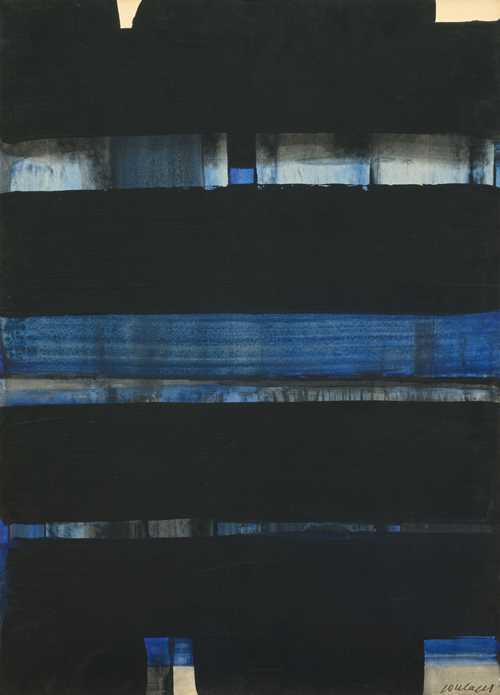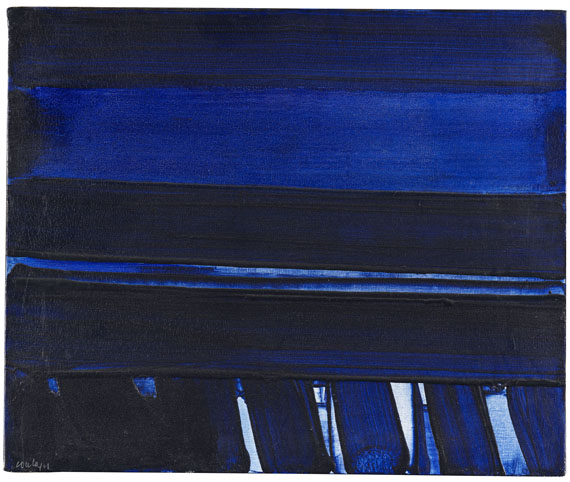Pierre Soulages Follow Peinture 130 x 162 cm, 12 mai 1965 signed 'Soulages' lower right; further signed, titled and dated 'SOULAGES "Peinture 162 cm x 130 cm 12-5-65"' on the reverse oil on canvas 130 x 162 cm (51 1/8 x 63 3/4 in.) Painted in 1965.
Provenance Kootz Gallery, New York Ernesto Regulado, San Salvador (acquired in 1965) Gimpel Fils, London Gimpel and Weitzenhoffer Gallery, New York Mr and Mrs Gerson Bakar, San Francisco (acquired in 1976) Private Collection, Paris Sotheby's, London, 21 October 1999, lot 85 Acquired at the above sale by the present owner Exhibited New York, Kootz Gallery, Soulages at Kootz , 1965 Literature Pierre Encrevé, Soulages: L'Oeuvre Complet Peintures, 1959-1978, vol. II, Paris, 1995, no. 554, p. 156 (illustrated) Catalogue Essay Drawing the viewer into an ethereal and vast colour field, Pierre Soulages’ Peinture 130 x 162 cm, 12 mai 1965 oscillates between a state of stasis and ephemerality, toying with darkness and light. In the present work, Soulages covers the canvas with commanding sweeps of inky black paint, largely subsuming, but also heightening, the radiance of the underlying ochre swathes. Evidencing the profound evolution of Soulages’ prolific practice, in which the dense impasto of his earlier works gave way to fluid, flat expanses of paint and an increasingly varied palette, the present work debuted at the artist’s solo exhibition at the Kootz Gallery in New York in 1965 alongside twelve other paintings, including Peinture 92 x 73 cm, 7 mars 1965 now housed in the Museum of Fine Arts, Houston, and Peinture 159 x 201.9 cm, 29 juin 1965, now in the collection of the Art Institute of Chicago. Exquisitely rendered with masterful tonality, Peinture 130 x 162 cm, 12 mai 1965 is exemplary of Soulages’ prolific experimentations with black , suspending the viewer in a moment of meditative reflection. Painted in 1965 as one of twenty four canvases created that year, the present work marks the moment in which Soulages’ reputation as one of the leading proponents of post-war abstraction was firmly established on an international stage – a position that was cemented by his seminal retrospective at the Museum of Fine Arts, Houston, the following year, and in 1967 at the Musée National d’Art Moderne, Paris. Commencing his productive career in the wake of the Second World War, Soulages pursued a wholly abstract style of painting from the beginning of his oeuvre, exhibiting his revolutionary canvases for the first time publicly at the Salon des Indépendants Paris in 1947. With brushstrokes seemingly akin to that of the Abstract Expressionists, Soulages did not solely seek to reflect his inner being or sense of self through his application of paint. Rather, as he postulated, ‘I always wanted my paintings to be objects, or rather, things’ (Pierre Soulages quoted in Hans-Ulrich Obrist, ‘An Interview with Pierre Soulages’, Perrotin , 24 January 2017, online). Suppressing any references to narrative, Soulages, to this end, titled his works with their physical dimensions and date of execution, deliberately constructing his compositions in pursuit of formal balance. Powerfully encapsulating Soulages’ dictum that ‘the more limited the means, the stronger the expression’, Peinture 130 x 162 cm, 12 mai 1965 represents a key stage in the artist’s oeuvre between 1963 and 1967, characterized by a simplification of materials. In contrast to the overlapping, black gestural strokes of his earlier paintings, his immense graduated layers of flat and opaque black invade the picture plane, providing his canvas with an increased sense of monumentality. The present work is a consummate example of the artist’s enduring commitment to the colour black, the cornerstone of his aesthetic enquiry, which has culminated in Soulages’ later series of totemic monochrome canvases which the artist continues to develop. The present work illustrates how Soulages, the ‘master of black’, uses tonality as a means to explore the interaction of light. In his 1965 canvas Soulages exploits the potential of colour contrasts, juxtaposing the vestiges of the white canvas on the upper and lower right and orange-ochre paint with the dark, clouded mass of black, conjuring a sense of light
Pierre Soulages Follow Peinture 130 x 162 cm, 12 mai 1965 signed 'Soulages' lower right; further signed, titled and dated 'SOULAGES "Peinture 162 cm x 130 cm 12-5-65"' on the reverse oil on canvas 130 x 162 cm (51 1/8 x 63 3/4 in.) Painted in 1965.
Provenance Kootz Gallery, New York Ernesto Regulado, San Salvador (acquired in 1965) Gimpel Fils, London Gimpel and Weitzenhoffer Gallery, New York Mr and Mrs Gerson Bakar, San Francisco (acquired in 1976) Private Collection, Paris Sotheby's, London, 21 October 1999, lot 85 Acquired at the above sale by the present owner Exhibited New York, Kootz Gallery, Soulages at Kootz , 1965 Literature Pierre Encrevé, Soulages: L'Oeuvre Complet Peintures, 1959-1978, vol. II, Paris, 1995, no. 554, p. 156 (illustrated) Catalogue Essay Drawing the viewer into an ethereal and vast colour field, Pierre Soulages’ Peinture 130 x 162 cm, 12 mai 1965 oscillates between a state of stasis and ephemerality, toying with darkness and light. In the present work, Soulages covers the canvas with commanding sweeps of inky black paint, largely subsuming, but also heightening, the radiance of the underlying ochre swathes. Evidencing the profound evolution of Soulages’ prolific practice, in which the dense impasto of his earlier works gave way to fluid, flat expanses of paint and an increasingly varied palette, the present work debuted at the artist’s solo exhibition at the Kootz Gallery in New York in 1965 alongside twelve other paintings, including Peinture 92 x 73 cm, 7 mars 1965 now housed in the Museum of Fine Arts, Houston, and Peinture 159 x 201.9 cm, 29 juin 1965, now in the collection of the Art Institute of Chicago. Exquisitely rendered with masterful tonality, Peinture 130 x 162 cm, 12 mai 1965 is exemplary of Soulages’ prolific experimentations with black , suspending the viewer in a moment of meditative reflection. Painted in 1965 as one of twenty four canvases created that year, the present work marks the moment in which Soulages’ reputation as one of the leading proponents of post-war abstraction was firmly established on an international stage – a position that was cemented by his seminal retrospective at the Museum of Fine Arts, Houston, the following year, and in 1967 at the Musée National d’Art Moderne, Paris. Commencing his productive career in the wake of the Second World War, Soulages pursued a wholly abstract style of painting from the beginning of his oeuvre, exhibiting his revolutionary canvases for the first time publicly at the Salon des Indépendants Paris in 1947. With brushstrokes seemingly akin to that of the Abstract Expressionists, Soulages did not solely seek to reflect his inner being or sense of self through his application of paint. Rather, as he postulated, ‘I always wanted my paintings to be objects, or rather, things’ (Pierre Soulages quoted in Hans-Ulrich Obrist, ‘An Interview with Pierre Soulages’, Perrotin , 24 January 2017, online). Suppressing any references to narrative, Soulages, to this end, titled his works with their physical dimensions and date of execution, deliberately constructing his compositions in pursuit of formal balance. Powerfully encapsulating Soulages’ dictum that ‘the more limited the means, the stronger the expression’, Peinture 130 x 162 cm, 12 mai 1965 represents a key stage in the artist’s oeuvre between 1963 and 1967, characterized by a simplification of materials. In contrast to the overlapping, black gestural strokes of his earlier paintings, his immense graduated layers of flat and opaque black invade the picture plane, providing his canvas with an increased sense of monumentality. The present work is a consummate example of the artist’s enduring commitment to the colour black, the cornerstone of his aesthetic enquiry, which has culminated in Soulages’ later series of totemic monochrome canvases which the artist continues to develop. The present work illustrates how Soulages, the ‘master of black’, uses tonality as a means to explore the interaction of light. In his 1965 canvas Soulages exploits the potential of colour contrasts, juxtaposing the vestiges of the white canvas on the upper and lower right and orange-ochre paint with the dark, clouded mass of black, conjuring a sense of light















Try LotSearch and its premium features for 7 days - without any costs!
Be notified automatically about new items in upcoming auctions.
Create an alert